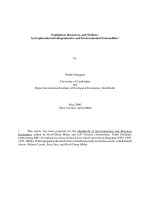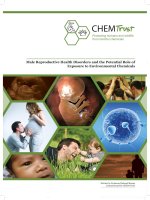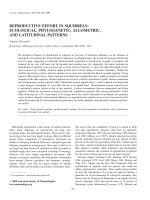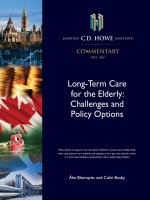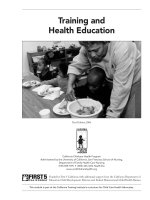DISORDERS and DISEASES: Cancer pptx
Bạn đang xem bản rút gọn của tài liệu. Xem và tải ngay bản đầy đủ của tài liệu tại đây (3.76 MB, 105 trang )
,IZABETH0EAK
,IZABETH0EAK
#ANCER
#ANCER
%LIZABETH3ILVERTHORNE
%LIZABETH3ILVERTHORNE
Elizabeth Silverthorne
Cancer
© 2009 Gale, Cengage Learning
ALL RIGHTS RESERVED. No part of this work covered by the copyright herein
may be reproduced, transmitted, stored, or used in any form or by any
means graphic, electronic, or mechanical, including but not limited to photo-
copying, recording, scanning, digitizing, taping, Web distribution, information
networks, or information storage and retrieval systems, except as permit-
ted under Section 107 or 108 of the 1976 United States Copyright Act, with-
out the prior written permission of the publisher.
Every effort has been made to trace the owners of copyrighted material.
Lucent Books
27500 Drake Rd.
Farmington Hills, MI 48331
ISBN-13: 978-1-4205-0113-1
ISBN-10: 1-4205-0113-5
Silverthorne, Elizabeth, 1930–
Cancer / by Elizabeth Silverthorne.
p. cm. — (Diseases & disorders)
Includes bibliographical references and index.
ISBN 978-1-4205-0113-1 (hardcover)
1. Cancer—Juvenile literature. I. Title.
RC264.S556 2009
616.99'4—dc22
2008047882
LIBRARY OF CONGRESS CATALOGING-IN-PUBLICATION DATA
Printed in the United States of America
1 2 3 4 5 6 7 13 12 11 10 09
Foreword 4
Introduction
Cells Gone Wild 6
Chapter One
What Is Cancer? 9
Chapter Two
Detecting and Treating Cancer 23
Chapter Three
Preventing Cancer 38
Chapter Four
Surviving Cancer 55
Chapter Five
The Future Outlook for Cancer 73
Notes 88
Glossary 91
Organizations to Contact 93
For Further Reading 96
Index 98
Picture Credits 103
About the Author 104
Table of Contents
4
foreword
“The Most
Difficult Puzzles
Ever Devised”
Charles Best, one of the pioneers in the search for a cure for
diabetes, once explained what it is about medical research that
intrigued him so. “It’s not just the gratification of knowing one
is helping people,” he confided, “although that probably is a
more heroic and selfless motivation. Those feelings may enter
in, but truly, what I find best is the feeling of going toe to toe
with nature, of trying to solve the most difficult puzzles ever
devised. The answers are there somewhere, those keys that
will solve the puzzle and make the patient well. But how will
those keys be found?”
Since the dawn of civilization, nothing has so puzzled people—
and often frightened them, as well—as the onset of illness in
a body or mind that had seemed healthy before. A seizure, the
inability of a heart to pump, the sudden deterioration of muscle
tone in a small child—being unable to reverse such conditions or
even to understand why they occur was unspeakably frustrating
to healers. Even before there were names for such conditions,
even before they were understood at all, each was a reminder of
how complex the human body was, and how vulnerable.
While our grappling with understanding diseases has been
frustrating at times, it has also provided some of humankind’s
most heroic accomplishments. Alexander Fleming’s accidental
discovery in 1928 of a mold that could be turned into penicillin
has resulted in the saving of untold millions of lives. The isola-
tion of the enzyme insulin has reversed what was once a death
sentence for anyone with diabetes. There have been great strides
in combating conditions for which there is not yet a cure, too.
Medicines can help AIDS patients live longer, diagnostic tools
such as mammography and ultrasounds can help doctors find
tumors while they are treatable, and laser surgery techniques
have made the most intricate, minute operations routine.
This “toe-to-toe” competition with diseases and disorders is
even more remarkable when seen in a historical continuum.
An astonishing amount of progress has been made in a very
short time. Just two hundred years ago, the existence of germs
as a cause of some diseases was unknown. In fact, it was less
than 150 years ago that a British surgeon named Joseph Lister
had difficulty persuading his fellow doctors that washing their
hands before delivering a baby might increase the chances of
a healthy delivery (especially if they had just attended to a
diseased patient)!
Each book in Lucent’s Diseases and Disorders series ex-
plores a disease or disorder and the knowledge that has been
accumulated (or discarded) by doctors through the years.
Each book also examines the tools used for pinpointing a di-
agnosis, as well as the various means that are used to treat or
cure a disease. Finally, new ideas are presented—techniques
or medicines that may be on the horizon.
Frustration and disappointment are still part of medicine,
for not every disease or condition can be cured or prevented.
But the limitations of knowledge are being pushed outward
constantly; the “most difficult puzzles ever devised” are finding
challengers every day.
Foreword 5
6
Cells Gone Wild
Cancer occurs when cells in the body multiply wildly and
abnormally. It is a serious, frightening disease. Cancer can oc-
cur in almost any part of the human body. Most often cancers
attack middle-aged and older adults, but some kinds of cancer
may strike at any age.
Cancer affects people all over the world. Though not conta-
gious, it is a common disease. More than 10 million new cases
are diagnosed each year, and more than half of these victims
will die from the disease. In the United States cancer is the
second leading cause of death, exceeded only by heart disease.
More than half a million Americans die of cancer each year. At
some time in their lives, almost everyone in the country will
be touched by the disease—either through their own illness or
that of someone they love.
A cancer diagnosis is scary, but not nearly as scary as it was
a few decades ago. In May 2008, a seventy-six-year-old man
lay in a hospital bed watching his favorite baseball team, the
Boston Red Sox, play the Kansas City Royals. The man was
Senator Edward Kennedy, who had been admitted to the hos-
pital for testing and would be diagnosed with brain cancer. The
pitcher for the Red Sox was twenty-four-year-old Jon Lester,
who had been diagnosed with non-Hodgkin’s lymphoma less
than two years earlier. Kennedy cheered as Lester pitched a
no-hitter. In Major League Baseball history, there have been
many no-hitters, but this one seemed like a miracle to baseball
InTroduCTIon
fans. After being treated with chemotherapy, Lester was back
on the mound—soon becoming the first Red Sox southpaw to
pitch a no-hitter in more than fifty years. After the game, Lester
spoke with reporters about his ordeal in battling cancer. “It
was a long road back,” he told them, adding, “I’m just glad that
I’m here at this moment right now.”
1
The day after Kennedy
was released from the hospital to return home and consider
his options for treatment, he went sailing—a favorite activity.
Cells Gone Wild 7
Jon Lester celebrates after pitching a no-hitter against the Kansas
City Royals on May 19, 2008. He had been diagnosed with cancer
less than two years earlier.
8 Cancer
Whether they are young or old, cancer patients—like Lester
and Kennedy—want to live their lives as normally as possible.
People with cancer need the support of their families and
friends to help them in what is often a long and painful fight,
and they need to be included as much as possible in activities
they enjoy.
In 1971 the United States government declared a war on can-
cer. Since then, billions of dollars have been spent to find new
weapons to fight the disease. Many scientists have spent mil-
lions of hours trying to find better ways of treating it. Others
have spent countless hours trying to find more effective ways
to prevent cancer. Since the late twentieth century, tremen-
dous progress has been made in detecting and treating cancer.
Doctors and patients no longer accept a cancer diagnosis as
an inevitable death sentence. In the twenty-first century, more
patients are surviving cancer than ever before.
Scientists still do not know why some people get certain
cancers and others do not. They do know, however, that many
cancers are preventable. It has been proven that avoiding
known risk factors such as tobacco smoke, excess sunlight,
and some chemicals and pollutants could prevent about half
the cancers that occur. A harmful lifestyle that includes poor
diet, lack of exercise, and alcohol abuse may put a person
at risk. As Donna Bozzone of Saint Michael’s College says,
“People have tremendous power to reduce their chances of
developing cancer by making good health and lifestyle deci-
sions. Even if treatments become perfect, prevention is still
preferable to avoid the anxiety of a diagnosis and the potential
pain of treatment.”
2
Although tremendous progress has been made in understand-
ing cancer, it is still a mysterious disease in many ways. There
are lots of myths and misconceptions about it, but doctors
believe the more people are informed about the disease and its
risks, the better chance they have of escaping or surviving it.
9
ChapTer one
What Is Cancer?
Cancer is not a single disease; it is a name given to at least
two hundred different diseases. Cancer occurs when normal
cells in the body behave in abnormal ways. The human body
consists of trillions of cells that are so tiny they can only be
seen under a microscope. The organs and tissues of the body
are made up of groups of these cells. All cells reproduce by
dividing—a process called mitosis. Usually, when cells are no
longer needed by the body for growth or repair of tissues, they
die. Some cells, however, continue to divide and refuse to die
when they are no longer needed.
Each cancer starts with one cell that reproduces uncontrol-
lably. This behavior is called mutation. As the out-of-control
mutant cells pile up, they form masses called tumors. When
these tumors become aggressive and invasive, they are said to
be malignant, or cancerous. Cancer can develop in almost any
organ or tissue of the body. From its original site, a cancer may
spread, or metastasize, to other parts of the body. When this
happens, the cancer is more difficult to treat and may become
life threatening.
Normal Cells and Cancer Cells
Normal cells and cancer cells are different in several ways.
Normal cells reproduce themselves exactly and stop reproduc-
ing when they are supposed to. They self-destruct when they
have completed their job or if they become damaged. Cancer
cells keep on reproducing and do not obey signals to stop.
10 Cancer
They have been called immortal because they refuse to die on
their own. Normal cells stick together. Cancer cells do not,
which allows them to become detached from their neighbor-
ing cells. Finally, normal cells mature and become specialized
in doing their job. Cancer cells remain immature and even
become more immature or primitive over time; they do not
perform any helpful function in the body.
DNA: The Cell’s Blueprint
Each cell in the human body contains long coils of deoxyribo-
nucleic acid (DNA). Strands of DNA look like twisted strings
of beads. Similar to the way letters are arranged in a sentence
to provide information, the way the beads in the DNA are
arranged provides information to the cells. Sections of DNA
called genes are blueprints or designs for making new cells.
Genes contain instructions that are passed down from genera-
tion to generation. The information in genes controls how a
person will look: eye and hair color, height, and many other
physical traits as well as some behavioral traits.
Genes in the DNA strand also contain complicated instruc-
tions that control the growth, division, and repair of cells.
A human colon cancer cell undergoes mitosis (division). Unlike
normal cells, cancer cells do not die, but continue to divide.
What Is Cancer? 11
When cells divide, each new cell gets a complete copy of all
the DNA instructions from the original cell. If the original cell’s
genes are damaged, the damage is passed on to the new cell.
The new cell can also acquire more damage, which it passes
along to its offspring. When the damaged cells multiply wildly,
cancer may result. Some substances that can damage cells’
DNA are cigarette smoke, chemicals, radiation, and excessive
sunlight. Substances that cause damage to DNA genes in such
a way that cancer may occur are called carcinogens.
An illustration of a DNA helix is shown here. Genes, which are
sections of DNA, are blueprints or designs for making new cells.
12 Cancer
Oncogenes and Suppressor Genes
Some genes encourage cells to multiply. This is important in
young people, who are still growing, but in adults it normally
does not happen very often. Exceptions to this are after a
wound or operation, when cells multiply to repair the dam-
Genetic Medicine: Blessing
or Curse?
In “Genetic Medicine: Powerful Opportunities for Good and
Greed,” Michael Dalzell says that while genetic treatments could
spawn incredible improvements in health care, they also raise
complex questions. He explains:
The theory of genetic diagnosis and treatment turns the
practice of Western medicine inside out—literally. Instead
of starting with disease and searching for its origin, genom-
ics begins with a genetic variation and relies on treatments
that manipulate it, often before the gene can express itself
in terms of illness. It bespeaks a change in the nature of
health care from treating symptoms to predicting health
status and taking steps accordingly.
Dalzell points out that while this concept fits the disease pre-
vention goals of managed health care, it requires expensive, highly
individualized treatment. Furthermore, it can be shocking to pa-
tients to know what their future is likely to hold. He asks, “At what
point do you say to a 13-year-old girl: ‘We’ve done genetic testing
on you, and somewhere around age 60, you’re going to develop
Alzheimer’s. You’ll have osteoporosis by around 40. And, oh, by
the way, you have an 80 percent chance of getting breast cancer’?”
Michael Dalzell, “Genetic Medicine: Powerful Opportunities for Good and Greed,”
Managed Care, May 2001, p. 4.
What Is Cancer? 13
age. When genes become overactive and tell cells to keep on
multiplying when there is no reason for it, scientists call them
oncogenes, or cancer genes. These are the villains that direct
cells to multiply excessively, ignoring normal stop signals.
Oncogenes have been found to contribute to cancers in many
places in the body, including the breasts, lungs, liver, bladder,
and colon. Along with the term oncogene comes the name on-
cologist for a doctor who specializes in treating cancer.
Fortunately, the body normally has a way to combat these
unruly oncogenes. Suppressor genes come to the rescue by lim-
iting cell growth or division. If oncogenes are like accelerators
in cars, then suppressor genes are like brakes. They stop cells
with damaged genes from reproducing and encourage them to
self-destruct. However, in cancerous cells, the suppressor gene
may be damaged, making it unable to stop cell multiplication.
One well-known suppressor gene is called p53, and in most
human cancers this suppressor is damaged or missing. When
genes transform into oncogenes and suppressor genes like p53
become inactive through damage, tumors may form.
Tumors
A tumor is a large group of cells that have clumped together
to form a mass of tissue. Some tumors are benign. A benign
tumor usually grows slowly. When it stops growing, it does
not spread beyond the place where it started. Benign tumors
are usually contained inside a wall or barrier called a base-
ment membrane, which is made up of proteins (molecules of
amino acids). Once a benign tumor is removed, it is not likely
to form again. It is a problem only if it grows very large and
becomes uncomfortable or unsightly, presses on other body
organs, takes up space inside the skull, or releases hormones
that cause trouble.
Malignant, or cancerous, tumors usually grow more quickly
than benign tumors. They break through the basement mem-
brane and invade surrounding tissue. They can become life
threatening when cells break away and spread to other parts
of the body, in a process called metastasis. There are two
14 Cancer
ways cancer cells spread through the body. They can travel
through the bloodstream to distant parts of the body. Since
the blood vessels in tumors are weaker and more leaky than
normal blood vessels, the tumor cells can escape and circulate
in the blood. Escaping tumor cells can also be carried in the
lymphatic fluid that bathes the body tissues. Then they can
establish metastatic colonies in the lymph nodes that drain all
of the tissues of the body. Once cancer cells invade another
body organ, they can grow new malignant tumors, called sec-
ondary tumors.
No matter where it spreads or how much it spreads, a can-
cer is always classified by the primary site where it started.
This is because wherever they are in the body, cancer cells
still possess many of the characteristics of the original tumor
cells. If a cancer starts in the breast and spreads to the lungs,
it is still classified as breast cancer. Or if a cancer starts in the
stomach and spreads to the liver, it is still classified as stomach
cancer. It is important to doctors treating the cancer to identify
the origin of the cancer so they can decide how to treat it. This
is because the organs of the body are made up of different
This illustration shows the spread of colon cancer from the
rectum to the liver.
What Is Cancer? 15
types of cells that behave in different ways. They may grow
at different speeds and be more or less likely to spread in the
blood. They also may respond differently to drugs or radiation.
How Tumor Cells Trick the Body
In order to survive, all the cells in the body need oxygen and
other nutrients and a way to dispose of waste material. Blood
brings these essential supplies to cells and also removes waste.
This is true not only for normal body cells but also for cancer-
ous cells in tumors. As a tumor grows bigger, the cells in its
center get farther and farther from the blood vessels surround-
ing it. The cancer cells are in danger of starving to death unless
they can develop their own blood supply. They need a clever
strategy to meet this challenge, and, unfortunately, they have
found it.
Normal cells stimulate new blood vessels to grow when
they need to repair damaged tissue. They have genes that can
switch the growth of blood vessels on and off. The formation
of new blood vessels is called angiogenesis. Aggressive cancer
cells send out a flood of SOS signals, by means of signaling
proteins that call for more blood. New capillaries (tiny blood
vessels) begin to sprout from the tissues surrounding the tu-
mor, and tumor angiogenesis takes place. When the tumor is
nourished by the new blood vessels, it begins to expand and
spread. Wherever it spreads in the body, the metastatic tumor
carries cells like those in the original, or primary, tumor.
Kinds of Cancers
Since there are so many different cancers, they can be clas-
sified in different ways. Most cancers, however, fit into one
of three main types: carcinoma, sarcoma, and leukemia/lym-
phoma. About 85 to 90 percent of all cancers are carcinomas.
These cancers begin in covering tissues of the body, such as
the outer layer of the skin. They also occur in the delicate tis-
sue that lines the mouth. Carcinomas may also arise in tissues
lining the internal organs, the chest cavity, the abdominal cav-
ity, and the organs of the digestive and reproductive systems.
16 Cancer
Sarcomas originate in connective and supporting tissues,
such as bones, cartilage, nerves, and fat. In addition to bone
cancer, sarcomas include cancer of skeletal muscles and Ka-
posi’s sarcoma, a skin cancer that sometimes appears in AIDS
patients. Sarcomas are usually divided into two main types:
bone sarcomas and soft tissue sarcomas. Together, they make
up fewer than 1 percent of cancers.
Cancers of the blood cells are called leukemias. Leukemias
arise in tissues where blood cells are produced, such as the
bone marrow. Large numbers of abnormal white blood cells
fill the bone marrow and enter the bloodstream. They interfere
with the production of red blood cells and cause problems like
bleeding and anemia. Leukemia is one of the most common
cancers affecting children.
Lymphomas are cancers that develop in the lymphatic sys-
tem. This system includes the lymph nodes, tonsils, adenoids,
spleen, and bone marrow. The lymphatic system fights off
germs that cause infection and illness. Lester, the Red Sox
pitcher, was diagnosed and treated for a form of lymphoma
called non-Hodgkin’s lymphoma.
This illustration shows a carcinoma on the stomach wall. Carcinomas
account for about 85 to 90 percent of all cancers.
Estimated Deaths by Gender
and Type of Cancer, 2008
18 Cancer
Cancer Causes: Heredity or Environment?
It has been established by experts that cancers can be familial,
or inherited, or sporadic, occurring at random in the popula-
tion. Although most tumors arise in people with no family
history of the disease, there is good reason for researchers to
study both causes.
Damaged or mutated genes can be inherited. When doc-
tors establish a patient’s medical history, they ask about close
relatives who have had cancer and what kind of cancer they
had. Doctors know that some types of mutated genes can be
passed from parents to children. They are aware that patients
with a family history of certain cancers are more vulnerable to
that type of cancer. But they also know that although patients
with a family history of cancer are at higher risk, they are not
destined to develop cancer.
Sometimes cancers that occur in several family members
are just coincidental. They might also be caused by something
in the shared environment. Compared to tumors that occur
sporadically, the actual number of cases of familial cancer is
quite small. There are, however, certain types of cancer that
occur more often in families. These include some cancers
of the breast, prostate cancer, ovarian cancer, cancer of the
colon, skin cancers, and an eye cancer called retinoblastoma.
Genetic testing for the more common oncogenes is pos-
sible today. But this kind of testing is controversial. Although
genetic tests can predict whether or not a person is at risk for
certain familial cancers, many people prefer not to know. And
even those who discover that they do not carry an abnormal
gene mutation are still at risk for developing cancers that occur
sporadically.
Those whose genetic tests indicate they have inherited an ab-
normal gene can choose to have more frequent tests for cancer,
or they can opt for more drastic procedures. Experts have found
that those who carry the breast cancer gene BRCA have an 80
percent chance of developing breast cancer. Consequently,
some women who have tested positive for the BRCA gene have
more frequent mammograms. Still others choose to have their
breasts removed surgically to eliminate the risk, even if they do
not have cancer.
Genetic testing can cost thousands of dollars; however, some
cancer centers offer free testing in connection with research
studies. Some insurance plans will pay the costs of genetic test-
ing that is recommended by a person’s doctor. But some people
fear that those who have a known risk of cancer may have dif-
ficulty being hired for jobs or obtaining health or life insurance.
Carcinogens as a Cause of Cancer
Most cancers are not the result of inherited abnormal genes.
They are the result of environmental factors. Some carcino-
gens have been known and understood for a long time. Others
are being discovered through current research. The research
is difficult because many cancers develop from the combined
Women who are at a higher risk for breast cancer may choose to
have more frequent mammograms to check for the disease.
20 Cancer
effects of more than one carcinogen on the DNA. Carcinogens
enter the body through the skin or through the nose, mouth, or
other openings.
Sometimes it is apparent that people who work at particular
jobs tend to get certain types of cancer. Experts study chemi-
cals or other substances these people encounter in their work.
The first step is to test the suspect substance on laboratory ani-
mals such as mice or rats. If a large percentage of the animals
develop cancer, the researchers go on to evaluate the effect of
the substance on people. They do this by comparing a group
of people who have been exposed to the agent to a group of
people who have not been exposed. If the exposed group has a
higher rate of a certain cancer, this is strong evidence that the
substance is a carcinogen.
Asbestos is an example of a cancer-causing agent that
took years to discover. Asbestos was once commonly used
Pets Get Cancer, Too
Veterinarian Karen Halligan says cancer is one of the leading
causes of death in pets and accounts for nearly half of all deaths
in cats and dogs over the age of ten. She says:
Dogs suffer from more kinds of cancer (at least 100) than
any other domestic animal, and one in four will develop
the disease in its lifetime. Just like people, pets can develop
cancer from exposure to sunlight, smoke, asbestos, chemi-
cals, hormones, radiation and viruses, and from immune
system failures. And some breeds have hereditary risk fac-
tors, among them golden retrievers, boxers and bulldogs.
Like humans, pets can be treated with surgery, chemotherapy,
radiation, immunotherapy, or a combination of treatments.
Karen Halligan, “How to Protect Your Pet from Cancer,” Parade, May 11, 2008, p. 13.
as a building material. Workers in the construction business
inhaled large amounts of asbestos fibers in the course of
their work. Years later, many of them developed lung can-
cer. Although asbestos is no longer used in buildings, many
older buildings still contain this substance. If these structures
undergo renovation or are torn down and the asbestos is dis-
turbed, the fibers float in the air and cause cancer if they are
breathed in.
Through experiments, scientists have identified hundreds of
chemicals that can cause cancer in animals. Some of these may
also be hazardous to humans. One of the deadliest is cigarette
smoke, which contains dozens of chemical carcinogens. In
addition to lung cancer, smoking causes many cancers of the
mouth, larynx, esophagus, pancreas, kidney, bladder, cervix,
and some forms of leukemia. It can also cause cancer in non-
smokers who live or work closely with smokers.
A sign warns that a building contains asbestos. Asbestos is a
material once commonly used in construction, but now is a
known carcinogen, or cancer-causing agent.
22 Cancer
Radiation is another well-known carcinogen. It comes from
different sources, but the most common source of cancer-
causing radiation is the sun. Its invisible ultraviolet rays cause
most cases of skin cancer, including deadly melanoma. Nu-
clear radiation can also cause different kinds of cancer, which
sometimes do not appear until years after exposure.
At this time, experts have not determined that viruses are a
major cause of human cancers. It has been shown, however,
that the human papillomavirus (HPV) causes most cases of
cervical cancer. Other viruses may cause cancer of the liver and
adult T-cell leukemia. One of the viruses that spreads mononu-
cleosis (commonly called the “kissing disease”) is the Epstein-
Barr virus (EBV). Nasopharyngeal cancer, which involves the
area at the back of the nose, has been linked to EBV. There also
seems to be a link with Hodgkin’s disease, since people who
have had EBV-related illnesses, including mono, are more likely
to contract Hodgkin’s disease than those who have not.
Dealing with Cancer
Cancer is a very complicated disease. It appears in many
shapes and forms and has many tricks and ways of surviving.
All the problems involved in preventing, diagnosing, and treat-
ing it will take many more years to solve. However, as Barbara
Basler says in “Good News About Cancer”: “Cancer is still a
formidable foe, but in the last few years alone, scientists have
gained intimate knowledge of this enemy and are using it to
outmaneuver these deadly cells—prolonging life and improv-
ing cure rates for thousands of patients.”
3
23
ChapTer Two
Detecting and
Treating Cancer
The earlier a cancer is detected, the better a person’s chances
are of a full recovery. For many cancers, early treatment can
prevent the cancer from growing, invading other organs, and
spreading to other parts of the body. Unfortunately, cancer is not
always easy to identify, since symptoms vary greatly and may be
similar to symptoms of many other illnesses. Sometimes there
are no symptoms at all. Before the mid-1950s cancer was called
“the silent killer.” By the time they saw a doctor, most cancer
patients already had advanced cancer that had spread to other
parts of the body. Today, scientists are constantly finding new
and better ways to detect, diagnose, and treat cancer. It is most
important, however, for individuals to be aware of how they can
help detect cancer at an early stage.
Cancer’s Warning Signs
The American Cancer Society (ACS) recognizes seven warning
signs that may indicate cancer:
Change in bowel or bladder habits
A sore that does not go away
Unusual bleeding or discharge
Thickening or lump in neck, breast, or other area
Indigestion or difficulty swallowing
Obvious change in wart or mole
Nagging cough or hoarseness
24 Cancer
The first letters of the seven signs spell “caution.” People
who note one or more of these signs may not have cancer,
but they should report their symptoms to their doctor. An-
other suspicious symptom is unusual tiredness, especially
when it is combined with one of the seven signs listed by
the ACS.
The ABCDE Rule
Melanoma, the most serious kind of skin cancer, is a widespread
type of cancer in the United States. Physicians say it is important
that everyone keep a careful watch for any changes in moles on
their bodies, as these could be signs of melanoma. Doctors rec-
ommend checking moles using the ABCDE rule:
A for asymmetry
A mole that does not look the same on both sides.
B for border
A mole with edges that are ragged or fuzzy.
C for color
A mole that varies in shade from dark brown to red or
blue or that has lost color.
D for difference
A mole that has changed in size, shape, or color or be-
come itchy.
E for elevation
A mole that is raised above the skin and has an uneven
surface.
If any of these symptoms exist, it is recommended that the
individual schedule a checkup with a dermatologist.



